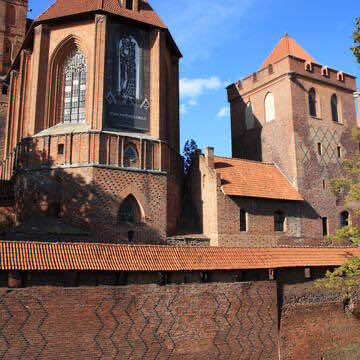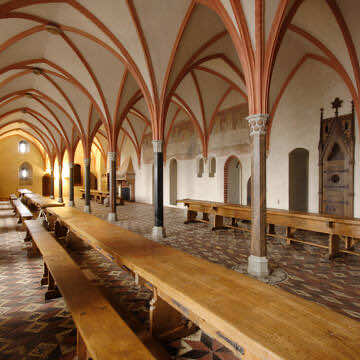The Castle of the Teutonic Order in Malbork is a 13th-century Teutonic castle and fortress located near the town of Malbork, Poland. It is one of the largest castles in the world measured by land area and a UNESCO World Heritage Site. The castle is a classic example of a medieval fortress and, on its completion in 1406, was the world’s largest brick castle.

Malbork was constructed by the Teutonic Knights. They did it in several stages, starting from 1274. Initially (from 1280) the castle served as a fortress for one of the Commanders and his garrison. In 1309 it became a seat of the Grand Master of Teutonic Knights, and the fundamental element of defensive system in Teutonic Prussia. In the 14th century Malbork got a form of triple defensive complex consisting of: the High Castle (monastery), the Middle Castle (the political and administrative centre of the monastic state) and the Outer Bailey (a vast economic base). In 1457 Malbork – bought from hands of the Teutonic Knights’ mercenaries – opened its gates to the king Casimir Jagiellonian. For more than three centuries the castle was a royal temporary residence, Polish war-base in Prussia and a seat for the district governor. In 1772 the first partition of Poland occurred and Malbork was lost to German Prussia, serving as a military quarters and warehouse for centuries before undergoing some restoration in the 19th and 20th centuries. It was ultimately returned to Poland in 1945.

It is the most complete and elaborate example of a Gothic brick-built castle complex in the characteristic and unique style of the Teutonic Order. The style exemplified here evolved independently from those which prevailed in contemporary castles in western Europe and the Near East. This spectacular fortress bears witness to the phenomenon of the Teutonic Order state in Prussia. The basic material for the construction of the castle was brick, limestone and granite. The foundations and elements exposed to destruction were laid out from the granite, architectural details were made of stone, and the bricks and timber were used to construct the basic parts of the buildings. The stronghold was placed on the right bank of the Nogat, in a defensive site. It was a long elevated strip of land, surrounded on the west and partly north by the river, and on the east by extensive swamps. Elements essential to Gothic architecture, such as spires, magnificent ribbed vaults, decorative battlements and Gothic arches are visible on, and inside almost every structure present in the complex.

The Malbork castle is considered one of the largest in the world and at the same time one of the most remarkable works of defense and residential construction in medieval Europe. Palace of Grand Masters on the middle castle is one of the most outstanding achievements of the European Gothic. The castle is also a monument showing the development of conservation thought, from the early nineteenth century to modern times.


